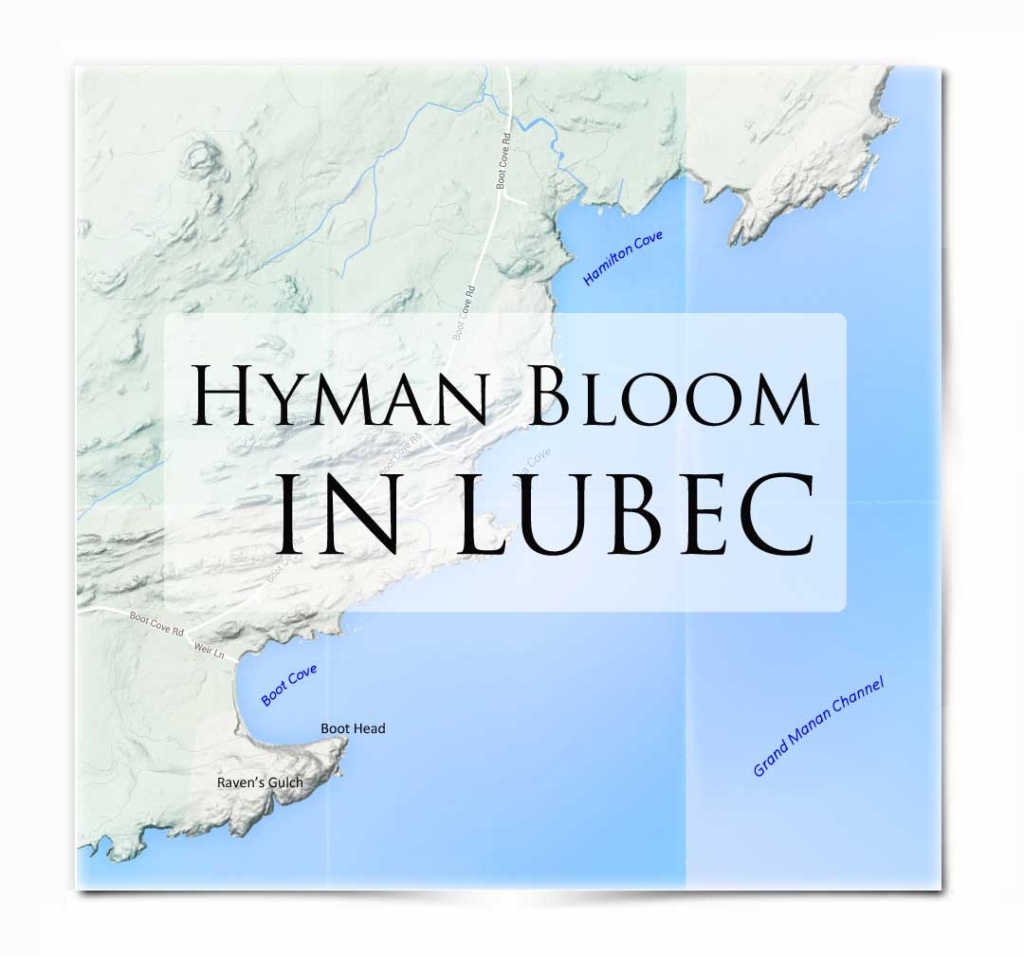© 2016, Robert Alimi
Acknowledgements: Many thanks to Nina Bohlen for sharing photos and information about life in Lubec. Thanks to Penny Caponigro for sharing stories about Lubec life as well as for providing excellent editorial assistance.
Notes on image viewing: This article includes 5 embedded slideshows. All the images included in the slideshows, plus a number of “bonus” images, can be viewed in a “gallery presentation” by following the gallery link included in the footnote section.
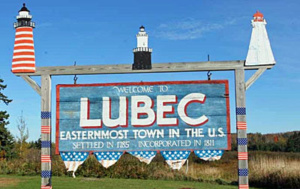
If you head north from Boston on US Route 1 and continue for 335 miles, you’ll eventually reach the small town of Whiting, located in sparsely populated Washington County, Maine. From Whiting, via State Route 189, it’s just another 11 miles to reach the town of Lubec. Today the Route 1 drive takes about 10 hours and would be described as the “scenic route”; back in the 1950s, before the creation of the Maine Turnpike, this was the fast route.
Hyman Bloom first made this trip in the summer of 1955 and continued making a summer trip to Lubec over most of the next 30 years. It wouldn’t be long before other artists1 in Bloom’s circle would start making the same trip to experience the unique coastline ecology at the mouth of the Bay of Fundy. From the high cliffs of the “Bold Coast” shoreline to the adjacent deep woods and bogs, the area provided a wild contrast to the sights and sounds of Boston.
How did Bloom, who rarely ventured outside of Boston in his first 40 years of life, end up spending so much time in Lubec? For the answer, we turn to Nina Bohlen.
NINA BOHLEN
Nina Bohlen grew up in Boston, the daughter of Henry Bohlen and Margaret Curtis Bohlen. Her father and mother separated when Nina was a small child and several years later her mother married Carleton Pike whose family had lived for generations in Lubec. Carleton had inherited the large family house in the town, and after the marriage the family spent summers in Lubec and winters in Boston. Two of Carleton’s cousins, bachelor brothers Sumner and Radcliffe Pike, lived in their family house just up the hill from Carleton and his family. Sumner was a member of the U.S. Securities and Exchange Commission and in 1946 was appointed by President Truman to be one of the first Commissioners of the newly formed Atomic Energy Commission. Radcliffe was a well-known botanist who taught at the University of New Hampshire for many years. Nina had known these uncles since childhood, and later Hyman got to meet them and appreciate their colorful tales of Lubec2 and the wide range of their knowledge. They remembered when Lubec prospered as the East Coast “sardine capital of the world”, similar to Monterey, California on the West Coast. When Hyman first went to Lubec in 1955, however, the town’s fortunes had waned and most of the canneries had closed.
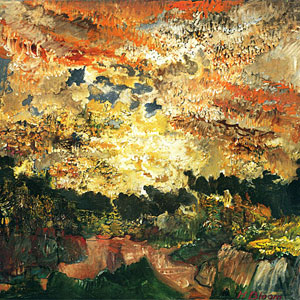
In 1952, when Nina was a junior at Radcliffe, she took a drawing class with Hyman. He had been appointed “Fogg Museum Fellow in Painting and Drawing” and “Lecturer on Fine Arts” at Harvard in 1951. In her senior year, Nina continued the drawing class and along with friend Ellen Sinclair, began to study painting in the evening at Hyman’s Boston studio. Hyman and Nina’s relationship eventually developed into a romantic one and they were married on September 29, 1954. Hyman got his first exposure to Lubec in August of 1955 when Nina’s parents gave the couple the use of their Lubec home for a week. Nina had always loved the Lubec area, but Hyman, having spent his entire life in an urban environment, was not initially won over. As Nina tells it, the weather was particularly foggy that summer, and the foghorn sounded incessantly during their visit. Hyman sat by the old wood stove trying to stay warm and asking when they might go back to Boston. Fortunately, he was willing to try another trip to Lubec the following year, and in the two weeks they were there in August of 1956 he began to venture out to explore the deep woods and cliff-lined shore of the “Bold Coast” that runs from Cutler up to Quoddy Head. He was hooked.
In the years that followed, Hyman and Nina would generally spend 3 weeks each summer in Lubec, typically in August when Nina’s parents would spend the month away from town. Although Nina and Hyman separated in 1957 (divorced in 1961), they remained very close friends and colleagues and Hyman continued his frequent summer visits to Lubec. To make the long trip in one day, Nina would insist on picking him up early in the morning – he would always grumble about having to get up so early – and they would be on their way. After Hyman remarried in 1978, he and Stella, his new wife, traveled to Lubec to visit Nina in 1984, 1985 and 1986.
THE BOLD COAST — CLIFFS, SUBARCTIC FLORA & FOG
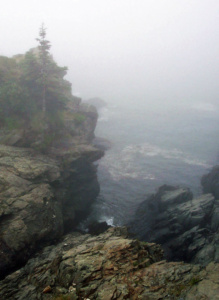
Lubec is the easternmost town in the US and quite literally the end of the road when heading up the eastern seaboard of the US. Across the 700′ wide channel known as the “Lubec Narrows” is Canada; specifically, Campobello Island, New Brunswick. The Lubec area features a wild, rugged coastline in what any Washington County resident would tell you is the true “DownEast” Maine.
Lubec sits at the mouth of the Bay of Fundy where the highest tides on earth occur; at the eastern end of the bay the difference between low tide and high tide can exceed 50 vertical feet. At the mouth of the bay, in the Lubec area, the tidal range is still an impressive 25 feet. This massive tidal range has contributed to the sculpting of the coastal cliffs, adding drama to the rocky coast left behind by the last period of glaciation.
The area features an unusual microclimate. The coastal area from South Lubec down to Cutler, known as the “Bold Coast”, is essentially a narrow strip of subarctic land. This subarctic microclimate is due to the combination of very cool temperatures and high moisture content. The flora and fauna are characterized by many subarctic species that would normally be restricted to more northern latitudes or higher altitudes. Coniferous trees such as balsam fir, red and black spruce, pine, and hemlock dominate the forested coastline.
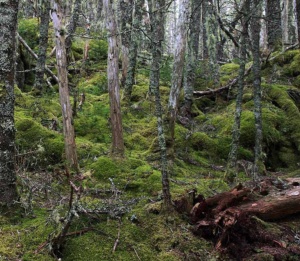
In many areas, just back from the cliff lined shore, often within a 100 yards or less, the landscape rapidly transitions to dwarf trees and shrubs. There are areas of coastal plateau bogs which support an array of unusual plants, including a number of arctic and subarctic species. Several varieties of carnivorous plants, including sundew and pitcher plant, survive in areas of low nutrient soils by feeding on insects.
On average, the area is enveloped by fog twice as often as the rest of the Maine coast. The combination of the large tidal range, the coastal subarctic microclimate and the intense fog, make the Bold Coast a truly unique area on the Eastern Seaboard.
IN LUBEC
With Nina’s guidance, and often in her company, Hyman began to seriously explore the Lubec area in the summer of 1956. He was drawn not to the ocean vistas, but to the thickly forested Bold Coast headlands. He would frequently spend all day exploring the dense stands of conifers, with many standing dead trees, and a forest floor carpeted with moss and lichen covered rocks. When not accompanying Hyman, Nina would drop him off in the morning and he would head off into the woods carrying one of his cameras and a sack lunch. She would pick him up in the late afternoon. He would hardly ever get lost. He did, however, lose his way one day on Boot Head as evidenced by a carving he left on a dead tree in the Raven’s Gulch area. Hyman carved “I have been lost and found myself at 2:30.” Hyman’s carved declaration remained for many years, but has since been lost to time.
Hyman didn’t carry sketching materials on his explorations but he would always have one of his cameras at the ready. Over the years he amassed a collection of hundreds of slides. Later he would study this ever growing photographic archive of the area and then as usual, work from imagination.
Hyman particularly liked spending time at Raven’s Gulch. In the early 1960s, photographer Paul Caponigro accompanied Hyman to this area on one occasion and shot many photos of him exploring and taking his own photographs (see slideshow 1, slides 1 -3).
Hamilton’s Cove was another area where Nina and Hyman would spend a lot of time. Slideshow 1, slide 4 shows Hyman photographing a cliff wall at the Cove. Although most of his work would focus on deep woods scenes, he did a number of drawings featuring shoreline cliffs and caves. He also liked to explore the Quoddy Head area in what is now Quoddy Head State Park, following the trail that weaves along the cliff tops.
Nina and Hyman enjoyed visiting Campobello Island. Prior to the building of the Franklin Delano Roosevelt Bridge, they would make the short ferry trip to the island and then head for favorite destinations such as Raccoon Beach on the east side of the island. At the northern end of Campobello, at Wilson’s Beach, there was a haddock processing plant where they would stop by to get fresh fish for dinner as well as the occasional extra bucket of haddock heads. During those years, their guests would sometimes be surprised to find assorted fish heads spread out on the back porch for Hyman to study and photograph.
Because the house was large, Nina and Hyman often invited guests to stay. Kahlil Gibran wanted to learn about mushrooms and enjoyed the opportunity to take people on collecting expeditions to Quoddy Head. Marie Cosindas liked to cook mussels Greek style and found them in the waters of Mill Cove on Campobello. Then there were the beach picnics to Hamilton’s Cove which neighbors Lois and Ryerson Johnson3 would organize. Fish was grilled over an open fire and potatoes were boiled in sea water. Food was eaten from driftwood “plates”. Dessert was often wild blueberries growing at the Cove and ripe for picking in August. Hands were washed in the icy ocean water. Hyman loved these outings.
Kahlil and Jean Gibran first visited Hyman and Nina for a week in August of 1957. In her book Love Made Visible4, Jean tells the story of passing through customs on their return from a Campobello visit:
“Standing beside the driver’s window, the agent perfunctorily asked us all where we were born. ‘Newton, Boston, Lynn,’ three of us answered. ‘Latvia,’ added Hyman. ‘Latvia, where’s that?’ queried the agent. Aware that anyone born outside the U.S. needed a passport, Nina assured him, ‘Oh, that’s a Boston suburb.’ We laughed on the way back to the manor house. Nina had saved the day.”
Good conversations were always to be enjoyed at the Pike house up the street where Sumner and Radcliffe Pike lived and where they welcomed guests every evening from 5-6 o’clock. Hyman and Nina were encouraged to attend and bring any house guests. Then, too, there were musical evenings at the house. Hyman played a variety of stringed instruments. Ryerson Johnson would sometimes bring over his musical saw.
Between the outdoor explorations, the visitors and the social activities, Hyman and Nina’s 3 weeks in Lubec would always pass quickly. Truth be told, Nina would sometimes feel relieved to be heading back to Boston after running the “Bohlen-Bloom Artist Retreat & Guest House” for another 3 week season in Lubec.
THE DRAWINGS & PAINTINGS
The 1950’s: “Seascapes”
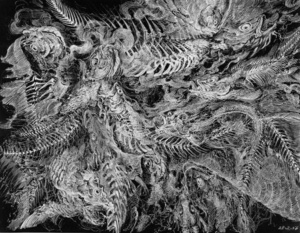
In 1956 Hyman started working on drawings that featured fish heads and fish skeletons. It would be a theme that he continued to develop over the next 30 years. As much “fishscapes” as “seascapes”, the works are instantly recognizable as “Bloom”. He had used fish as a subject before, but it was the Lubec experience that led him to fully embrace this subject as a major theme. He produced many fish drawings from the mid to the late 50’s; the drawings were frequently done on dark paper using white ink.
A seminal work from 1956 is Law of The Fishes. In this drawing, Hyman drew upon his long standing interest in Eastern philosophy to create a work that would serve as a springboard for a series of large paintings over the subsequent 3 decades. The work is rooted in the Hindu concept of matsya nyaya. Matsya nyaya (the law of the fishes) describes that state of nature, where the large fish prey upon the small fish.
Devdutt Pattanaik elaborates:
“Nature is governed by matsya nyaya, or the law of the fishes, where the big fish eats the small fish. Matsya nyaya means the same thing as jungle law or might is right or survival of the fittest. Culture is born when this law of jungle is rejected. Culture creates laws and rules and rituals that seek to help the helpless, give rights to the meek not just the mighty, make room for the unfit not just the fit. To do so is dharma (potential or capability or capacity) for humans.”5
In a 1986 interview with Lois Tarlow, Bloom stated “Eating, pursuit, and dying. It’s a euphemism for free enterprise, a predatory competition. Life is a contest.”
The 1960’s: Deep Woods Drawings
In 1962, Hyman would begin to focus exclusively on drawing. As he explained to Dorothy Thompson:
“ I thought by reducing the variables I could get to fundamental issues. The Sung painters, after all, have a complete aesthetic in black and white, and I had hoped by imposing such limits I might be able to give greater strength to the whole composition. Also I wanted to explore charcoal tone as Redon had done, and pursue ideas I had developed from studying the drawings and prints of Altdorfer and Bresdin.” 6
As the principal subject material, he used his experiences in the thick woods along the cliff tops of the Bold Coast area, particularly the Boot Head area. The work was widely exhibited and universally well received by critics.
“It is not to be missed. I was particularly swept away by the landscapes which remind one of Altdorfer, Bosch, Bresdin, Blake and all other Gothic and romantic masters of dense detail and mystical inspiration, But after a visit to the San Francisco Museum… [they],.. will remind one forever of Hyman Bloom.” – Alfred Frankenstein, San Francisco Chronicle, July 10, 1968
The Landscape Paintings
When Hyman resumed painting in the early 1970s, he began work on a series of landscape works in oil inspired by the Lubec woods. The paintings from this period are noticeable for their smaller formats and cooler palettes. The molten colors of the 1950s work have been replaced with the cool blues and greens of the Lubec woods. Known for his famously slow place of work, when he returned to oils after his long break, he produced a relatively large number of works, with at least 12 oils being completed in 1973 — that was double his usual output.
The Seascape Paintings
In the early 70’s Hyman also returned to the “seascape” theme. The large scale paintings produced in this period are based on his iconic Law of the Fishes drawing from 1956. These seascapes were done in two series and titled numerically within the series: Seascapes I through V in the First Series and Seascapes I through III in the Second Series. Most of these paintings are now in public collections, including Danforth Art, De Cordova Museum and the Hood Museum at Dartmouth College. One is hanging as the centerpiece of Roger Berkowitz’s office, the CEO of Legal Seafoods.
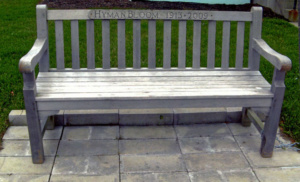
Conclusion
Throughout his career Bloom worked within a relatively small number of themes: the christmas trees, rabbis, chandeliers, archaeological sites, and cadavers of the 40’s, and the autopsy paintings of the early 50’s. Starting in the mid-50s, his journeys to Lubec led to the introduction of significant new themes to his body of work. The early and late “seascape/fishscape” paintings, the large format deep woods drawings of the 1960’s, and the landscape paintings of the 1970’s and 1980’s became central to his work for the 3 decades coincident with his trips to Lubec. With the landscape drawings, he had found an avenue of applying ideas he had developed from studying the work of Bresdin and others, and developed new themes that extended his work exploring the fundamental aspects of organic transformation.
After years heavily focused on autopsy and cadaver pictures, Hyman sought to move in a new direction7 and Lubec provided rich inspiration for much of his work starting in the mid-50s and continuing on for the next 30 years.
-Robert Alimi
Image Gallery link, End notes and links to additional resources
View all the images in this article in a gallery style presentation. Includes a gallery of “bonus” images.
End notes:
1) In addition to Hyman Bloom, and of course Nina Bohlen, artists who would venture this far “east” include Paul Caponigro, Marie Cosindas, Nicholas Dean, Kahlil Gibran, Marianna Pineda, Harold Tovish, Ellen Sinclair and Stephen Trefonides.
2) For stories about the early days of Lubec, see:
Grandpa Was a Smuggler, by Sumner Pike, as told to Sidney Shalett,Saturday Evening Post, August 28, 1948
200 Years of Lubec History: 1776-1976, Ryerson & Lois Johnson and The Lubec Historical Society. This publication features original drawings by Bloom, Nina Bohlen, Lois Johnson and Steven Trefonides.
3) Lois & W. Ryerson Johnson: Ryerson “Johnny” Johnson was a well known author of adventure and pulp fiction novels. His wife Lois was an author and illustrator. Below is an excerpt from his unpublished autobiography, portions of which are are available online.
…(Lois) and Johnny met “in the studio of the sculptor, Gozo Kawamura, on 6th Avenue a few doors below 14th Street [in New York City]. A pertly smiling, exquisitely tiny thing, she was up on a ladder sticking toothpicks in the side of a monumental statue of a horse. That’s what I thought. Actually, she was gobbing gray plastilene onto the statue armature, filling it out to the ends of the toothpicks. Gozo Kawamura…had invented an impressive Goldbergian enlarging machine that brought so many urgent orders from other sculptors for enlarging their small originals cast in plaster, that he hardly had time for his own work. With Lois assisting, he was enlarging statues all over the place. They did Prometheus, the golden boy who stretches out above the skating rink just off Fifth Avenue at Radio City. They did the U.S. Supreme Court statue enlargements, and went down to Dallas to do the Texas Centennial pieces.”
Lois had come to NYC from Duluth, Minnesota. “I got very interested in Lois, and when she went home for a while to Duluth, I practically commuted between New York and Duluth.” At that time Lois had also written and illustrated, in collaboration with Betz Princehorn, a children’s picture book called FIVE JAPANESE MICE AND THEIR WHISKERS, published by Farrar and Rinehart.
Lois and Johnny were married in 1938 “by a Japanese preacher in a Japanese American Dutch Reformed church in Manhattan.” [They] celebrated that night by attending the New York World’s Fair, and spent their honeymoon in an “old falling-down family mansion” Johnny had inherited in Lubec, Maine. That house, renovated, remained one of their two primary residences (the other for many years was Algonquin, Illinois) until Johnny’s death.
4) Love Made Visible: Scenes from a Mostly Happy Marriage, by Jean Gibran, Interlink Books, Northampton, MA, 2014
5) “The Real Ramrajya“, 15th December, 2013, Mumbai Mirror.
6) The Spirits of Hyman Bloom: The Sources of His Imagery, by Dorothy Abbott Thompson. Chamelion Books, 1996. Pg 55.
7) Ibid.
Additional Resources:- Hard copy
- The Drawings of Hyman Bloom. The University of Connecticut Museum of Art, Storrs, Connecticut, 1968. Essay by Marvin S. Sadik.
- Hyman Bloom: The Lubec Woods. Bates College, Museum of Art, Olin Arts Center, Lewiston, Maine, 2001. Essay by Phillip M. Isaacson.
- Online

